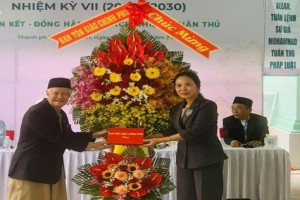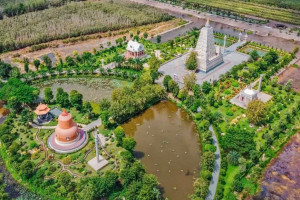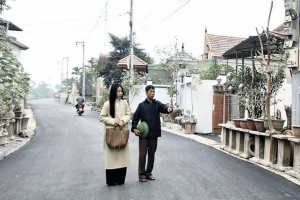
Spring is the season of festivals and the festive atmosphere is overwhelmingly felt in villages’ culture life throughout the country. During these festivals, thurification is an important and indispensable ritual.
Thurification or incense offering is a fine feature in the cultural tradition and folk belief of Oriental people in general and Vietnamese in particular. Incense offering appeared very early and has become an important and indispensable ritual during traditional festivals as well as in the worship of ancestors in each Vietnamese family. Incense is considered as a sacred bridge between the visible life of human beings and the spiritual world of heaven, earth and gods.
The burning of incense on the ancestral altar or altars of deities in families or communal houses, temples, pagodas, shrines and sacred sanctuaries is an indispensable traditional beauty in the first and fifteen days of the lunar months, death anniversaries or Tet holidays. Among offerings given to the ancestors and Gods, there must be some incense sticks. The aroma of incense warms the heart of everyone. Incense stick is no longer a normal object but becomes a spiritual one indispensable in each Vietnamese family. Along with other traditional customs, incense offering has contributed to establishing and preserving the cultural identities and values of the Vietnamese nation.
In terms of meaning, incense offering reflects people’s desire to contact with deities. In the primitive time, when people couldn’t explain supernatural phenomena in the world, they deified those phenomena and attached each of them to a deity. Human beings also defined deities as the Supreme Beings. They believed that deities could directly influence their life. That was the reason why they tried to communicate with Gods. No way could help people to fly. Only when finding a fire, people gradually recognized that smoke rose up from the fire. Since then, they used fire to communicate with deities.
The use of incense to communicate with deities has existed for a long time and now it is difficult for us to determine when people started to use incense. We can only confirm that this form of communication appeared very early. There are images of incense burning on the paintings discovered in the ancient pyramids of Egypt. The incense offering was popular in China before it developed in other countries in East Asia in the early CE (Christian Era).
People have created many different kinds of incense: incense sticks are small bamboo sticks with wood powder around the sticks; Incense coil has a cone shape and does not have a core; and incense piece is often made of aromatic wood. According to folk belief, the numbers of burned incense sticks are always odd numbers (1, 3, 5, 7, 9) because they represents prosperity and development. And the odd numbers (3, 5, 7, 9) have also several meanings in lives of the Oriental people.
When incense stick is burned, it manifests people’s spiritual desire and passes their prayers to deities. Thus, Vietnamese people feel uneasy when they go to temples or pagodas without incense sticks and candles. However, in the way of offering incense, they focus on how to express their prayer and wish. When offering incense, everybody needs to wear clothes in a decent and dignified manner and have respectful attitude. Vietnamese people avoid burning a bundle of incense and then placing it on the altar, because stuffy incense smoke is connected to impurity and lack of respect. People should hold each incense stick by both hands and respectfully place it on the altar. Incense sticks must be placed straightly, manifesting people’s honesty. The masters of rites in villages are usually the elderly while those in families are breadwinners. While offering incense to ancestors and deities, they must show their deep respect. The selection of those who undertake incense offering ritual is carried out carefully because if not, deities will punish villagers. And it is also an honor for the selected.
In many rural areas in Vietnam, people still maintain the custom of burning incense at the foot of the old trees or the corner of the house as they think that everything has its spiritual life, so the incense offering aims to seek deities’ help and support. In these places, the ritual is also carried out solemnly and respectfully as in temples and pagodas.
In religions as well as in folk beliefs, thurification is an important ritual and almost all religions practice this ritual in different forms during their festivals. Especially, in Buddhism, incense offering is an indispensable practice during its ceremonies and festivals. Incense offering and praying are always conducted first and at the most solemn and sacred moments of the ceremonies.
For Buddhism, incense is one of the six offerings, together with flowers, a candle or oil lamp, drink, fruit and food [3]. According to the Buddhist perception, sincerity is expressed through incense smoke and those available in the nature. There is no need for a big feast. Aromatic incense, light, fresh flowers and good fruits are enough. Buddha is not on the altar or in the statues, but in the heart of everyone.
Because of the perception “Buddha is in the heart”, Buddhism dignifies the sincerity of each believer. Offering incense to Buddha expresses the sincerity, respect and love of the followers, called Tam huong (incense of mind). Anyone who reaches Tam hương can practice the Dharma and release himself/herself from sufferings. So there are five types of Tam huong: Giới hương (the scent from keeping precepts); Định Hương (the scent from Zen mind); Tue Huong (the scent from wisdom); Giải Thoát Hương (the scent from self-salvation); and Tri Kiến Hương (the scent from self-reaching enlightenment)
In the important rituals of Buddhism, thurification is always essential and plays a special role. In addition to helping people to contact with deities and Buddha, incense offering also manifests the mercy and good mind of Buddhist followers. In the pervasive incense smoke in combination with melodious recitation of Buddhist teachings sounds, people seem to be sunk into the spiritual world, feel warm and become closer together.
Not only Buddhism but also other religions like Christianity use incense during religious rites. Christians burn incense before the Bible and the Blessed,…. In ancient times, frankincense was more valuable than gold and jewels because Christians believed that the aromatic species of plants were given by deities and were impregnated with the fragrance of Jehovah. Hindu believers burn incense when they relax and practice meditation. Meanwhile, according to Confucianism, incense smoke symbolizes honorable men as it only flies off.
The rituals of some native religions in Vietnam such as Hoa Hao Buddhism, Buu Son Ky Huong are very simple. Hoa Hao Buddhist followers worship Buddha through a piece of “brown cloth” [4]. Offerings to Buddha are incense sticks, flowers and water. According to Hoa Hao Buddhism, only the three offerings are displayed at the ancestral altar as well as the outdoor altar. Simple offerings but solemn rituals are enough to show the great spiritual values and faith in dharma.
Through space and time, the ritual of offering incense to gods and ancestors during festivals, New Year or death anniversaries has been passed from generation to generation. Incense stick has become a spiritual product in Vietnam’s traditional culture. Each burned incense stick can convey cultural and moral values, and together with other traditional customs, it has contributed to creating and preserving the cultural identities of the Vietnamese nation.
Phúc Nguyên




